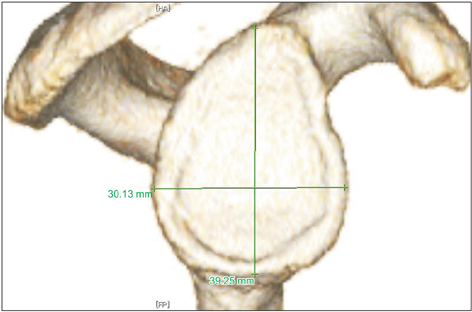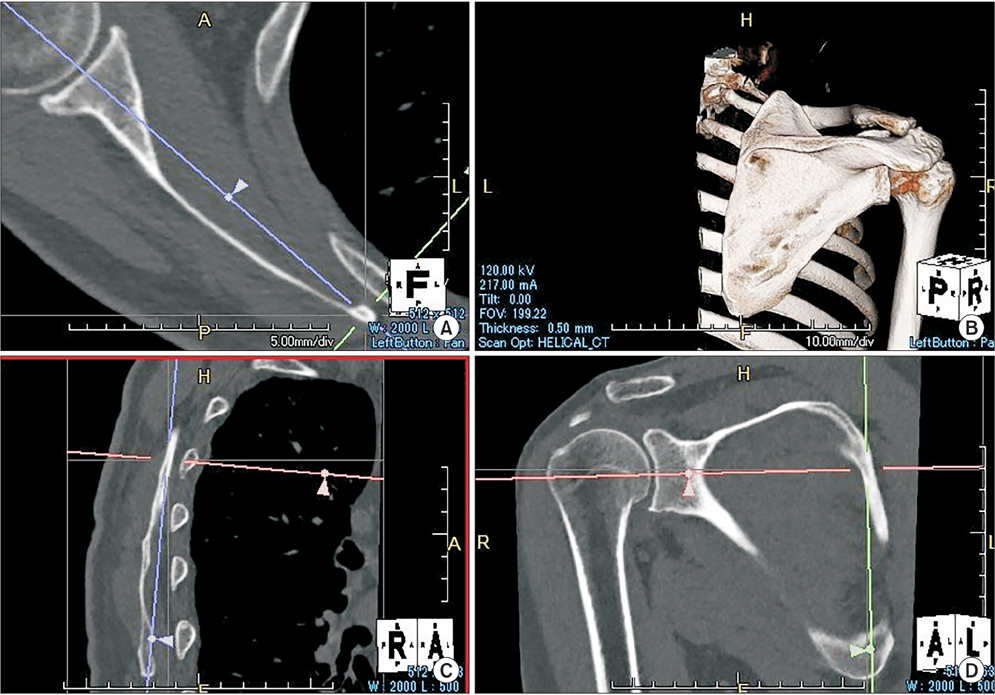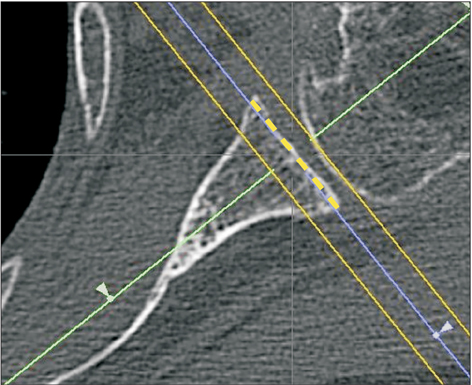Clin Orthop Surg.
2017 Jun;9(2):207-212. 10.4055/cios.2017.9.2.207.
The Dimensions of the Scapula Glenoid in Japanese Rotator Cuff Tear Patients
- Affiliations
-
- 1Department of Orthopaedic Surgery, Graduate School of Medicine, Kyoto University, Kyoto, Japan. arairyuzo@gmail.com
- KMID: 2412290
- DOI: http://doi.org/10.4055/cios.2017.9.2.207
Abstract
- BACKGROUND
Reverse total shoulder arthroplasty has become a widely accepted surgical procedure in Japan since the time when the implants were approved for use in 2014. There is a doubt, however, as to whether the implants designed for Western people are suitable for Japanese people, particularly for females of relatively small stature. The purpose of this study was to investigate the glenoid dimension, with special focus on the length after glenoid reaming, in Japanese rotator cuff tear patients.
METHODS
Fifty-six shoulders of 55 patients (35 males and 20 females; mean age, 63.8 years) were studied. Using the three-dimensional computed tomography images of the entire scapula before shoulder surgery, we measured the glenoid height and width, and calculated the correlation between these measurements and the patient's height. Further, we measured the anteroposterior length of the scapular neck at the subchondral bone and the length at 15 mm medial to the subchondral bone, to simulate both the glenoid width after reaming (width of the "˜virtual reamed surface') and the space available for the end of the center post of a standard glenoid baseplate.
RESULTS
The average glenoid height and width were 35.8 mm and 28.1 mm in males and 30.8 mm and 23.4 mm in females, respectively. There was a significant correlation between patient height and glenoid size (glenoid height, r = 0.69; width, r = 0.75; p < 0.01). The mean value of the width of the virtual reamed surface was 27.0 mm in males and 22.5 mm in females. The mean anteroposterior length at 15 mm medial to the subchondral bone was 12.4 mm in males and 9.5 mm in females; the length was shorter than 8 mm in 6 female shoulders.
CONCLUSIONS
There was a significant correlation between patient height and glenoid size. Considering that the common diameter of the commercially available baseplates and their center posts is greater than 25 mm and 8 mm, respectively, these prosthetic parts would be too large, especially for the Japanese female glenoid. Given that the current results of Japanese shoulder dimensions are similar to those of Asian people, "˜Asian size implants' should be developed.
Keyword
MeSH Terms
-
Adult
Aged
Aged, 80 and over
Asian Continental Ancestry Group/*statistics & numerical data
Female
Glenoid Cavity/*anatomy & histology/*diagnostic imaging
Humans
Japan/epidemiology
Male
Middle Aged
Prosthesis Design
Rotator Cuff Injuries/diagnostic imaging/*epidemiology/surgery
*Shoulder Prosthesis/standards/statistics & numerical data
Tomography, X-Ray Computed
Figure
Reference
-
1. Grammont P, Trouilloud P, Laffay JP, Deries X. Concept study and realization of a new total shoulder prosthesis. Rhumatologie. 1987; 39(10):407–418.2. Boileau P, Walch G. The three-dimensional geometry of the proximal humerus: implications for surgical technique and prosthetic design. J Bone Joint Surg Br. 1997; 79(5):857–865.3. Sirveaux F, Favard L, Oudet D, Huquet D, Walch G, Mole D. Grammont inverted total shoulder arthroplasty in the treatment of glenohumeral osteoarthritis with massive rupture of the cuff: results of a multicentre study of 80 shoulders. J Bone Joint Surg Br. 2004; 86(3):388–395.4. Smith CD, Guyver P, Bunker TD. Indications for reverse shoulder replacement: a systematic review. J Bone Joint Surg Br. 2012; 94(5):577–583.5. Matsumura N, Oki S, Ogawa K, et al. Three-dimensional anthropometric analysis of the glenohumeral joint in a normal Japanese population. J Shoulder Elbow Surg. 2016; 25(3):493–501.
Article6. Churchill RS, Brems JJ, Kotschi H. Glenoid size, inclination, and version: an anatomic study. J Shoulder Elbow Surg. 2001; 10(4):327–332.
Article7. Iannotti JP, Gabriel JP, Schneck SL, Evans BG, Misra S. The normal glenohumeral relationships: an anatomical study of one hundred and forty shoulders. J Bone Joint Surg Am. 1992; 74(4):491–500.
Article8. Ji JH, Jeong JY, Song HS, et al. Early clinical results of reverse total shoulder arthroplasty in the Korean population. J Shoulder Elbow Surg. 2013; 22(8):1102–1107.
Article9. Mihata T, Lee TQ, Watanabe C, et al. Clinical results of arthroscopic superior capsule reconstruction for irreparable rotator cuff tears. Arthroscopy. 2013; 29(3):459–470.
Article10. Kwon YW, Powell KA, Yum JK, Brems JJ, Iannotti JP. Use of three-dimensional computed tomography for the analysis of the glenoid anatomy. J Shoulder Elbow Surg. 2005; 14(1):85–90.
Article11. Shrout PE, Fleiss JL. Intraclass correlations: uses in assessing rater reliability. Psychol Bull. 1979; 86(2):420–428.
Article12. Walch G, Badet R, Boulahia A, Khoury A. Morphologic study of the glenoid in primary glenohumeral osteoarthritis. J Arthroplasty. 1999; 14(6):756–760.
Article13. Phonphok P, Kulkamthorn N. Assessment of approximate glenoid size in Thai people. J Med Assoc Thai. 2014; 97:Suppl 2. S14–S18.14. Chae SW, Kim SY, Lee H, Yon JR, Lee J, Han SH. Effect of baseplate size on primary glenoid stability and impingement-free range of motion in reverse shoulder arthroplasty. BMC Musculoskelet Disord. 2014; 15:417.
Article15. Jha SC, Fukuta S, Wada K, et al. Optimizing baseplate position in reverse total shoulder arthroplasty in small-sized Japanese females: technical notes and literature review. J Med Invest. 2016; 63(1-2):8–14.
Article
- Full Text Links
- Actions
-
Cited
- CITED
-
- Close
- Share
- Similar articles
-
- Displaced Scapula Fracture (Ideberg Type IIb) Combined with a Large Rotator Cuff Tear in Anterior Shoulder Dislocation: A Case Report
- Delaminated Rotator Cuff Tear: Concurrent Concept and Treatment
- Bilateral acromial stress fractures in a patient with a massive rotator cuff tear
- Biological Characteristics of Rotator Cuff Tendon
- Difference of Critical Shoulder Angle (CSA) According to Minimal Rotation: Can Minimal Rotation of the Scapula Be Allowed in the Evaluation of CSA?





